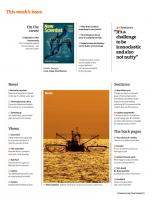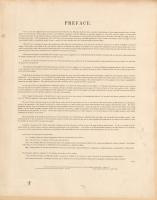Analytical model of human body joints
The joints in the human body are described using application-oriented computer language. They are based on computer-gene
375 41 233KB
English Pages [5]
Recommend Papers

- Author / Uploaded
- Uzunova V.
- Yankov K.
- Similar Topics
- Technique
- Electronics: Robotics
- Commentary
- 1552882
File loading please wait...
Citation preview
Biomedical Sciences
21
ANALYTICAL MODEL OF HUMAN BODY JOINTS Veselina Uzunova1, Kaloyan Yankov2, PhD Medical Faculty, Thracian University, Stara Zagora, Bulgaria 1 e-mail: [email protected] 2 e-mail: [email protected] ABSTRACT. The joints in the human body are described using application-oriented computer language. They are based on computer-generated analytical equations of limbs and computer programs for exploration and simulation of movements, making prosthesis and estimation of mobility, definition of biomechanical parameters of human motions, control and regulation of computer-aided motion of invalids, design of supervisor control of mechanisms. Key words: Biomechanics, Symbolic Computation, Kinematics.
INTRODUCTION Modeling of mechanical or biological systems and objects is a powerful tool in the area of scientific investigation. A computer model that precisely represents the original system can be used for accesment of its behavior in a variety of conditions. A serious problem in computer modeling is the user interface. Means for object description often turn out to be difficult to apply by users lacking technical and mathematical skills, especially in modeling human joints, which are very complicated systems from mechanical point of view. The user interface in applied software can be: graphic user interface, specialized language or its combination. In this paper an applicationoriented language is used to describe some important joints of the human body. This language is part of the user interface in the CINDY simulation system for modeling of open kinematics chains [9,10]. The goal of this study is to obtain the analytical equations of limbs as a basis for computer simulation and investigation. OPEN KINEMATICS CHAIN In computer modeling there are two main approaches: numerical and analytical. Numerical methods [7,8] are widely used. Analytical [3,5,11] and numerical-analytical models [12] are typical for computer systems used for artificial intelligence problems. Their advantages are discussed in the specialized literature. The human skeleton can be modeled as open kinematics chains (OKC). OKC is a system of rigid bodies called links which are connected Jubilee Scientific Conference 18-20.10.2002
М
22
-
pairwise to each other to transmit a force or motion. A kinematic pair (KP) or joint is composed of contacting surfaces between two links that keep them in contact and that is relatively movable. KPs are revolute (R) or prismatic (Р). Living organisms only contain rotation joints. The independent possible movements in an OKC are called degrees of freedom (DF). To position and orient a body in the three-dimensional space 6 DFs are necessary – three translations and three rotations (one for each axis). Each joint in a technical systems has only one DF and this restriction is technological. But joints in biological systems can have 2 or 3 rotations and that is why the DFs of a limb exceed 6. This increases the mobility and the opportunity to compensate for restrictions in some joints at the expense of redundancy [1]. The independent movements are also called “kinematics parameters” and are denoted by the vector q: q = (q1,q2,….,qN)T (1) To describe a OKC whether technical or biological in the threedimensional space is extremely challenging task. Most of the proposed models of KPs in the literature are two-dimensional [4,6]. But their usefulness is limited mainly to illustrative purposes and they have limited application. This makes creation of three-dimensional models a valuable and popular area of investigation. SPATIAL DESCRIPTION OF OKC. There are different approaches possible to describe an OKC in threedimensional space. The most widely used is the Denavit- Hartenberg notation [2]. This approach is based on the following principles. A local Cartesian coordinate system is established for each rigid body. The base coordinate system attached to the fixed segment is denoted OoXoYoZo and for i-th kinematic pair the frame is OiXiYiZi (i=1...N, N is the number of joints) – Fig.1.
- axis Zi coincide with the axes of the i-th kinematics pair; - axis Xi is a common perpendicular to the Zi-1 and Zi : Xi = Zi-1 x ZI; - axis Yi is chosen to define right-oriented frame OiXiYiZi. The relative position of two coordinate systems attached to Fig.1 Ю
р
я 18-20.10.2002 .
Biomedical Sciences
23
adjoining joints is described with four parameters: a,α,θ,s. The transformation between two adjacent frames depends of these parameters and it is described using a homogeneous transformation matrix. Let BN be the characteristic end-effector point in N-th frame. Its homogeneous coordinates in OoXoYoZo frame are:
B0,N = ПАk-1,k(qk)*B k=1,2,…,N (2) where Аk-1,k(a,α,θ,s) is the transformation matrix from (k-1)-th to kth frame. That is the kinematic model of an OKC. To generate these equations of joint movement is a long process requiring mathematical skills. This is done quickly and made easy by a computer program.
LANGUAGE FOR DESCRIPTION OF OPEN KINEMATIC CHAINS In [13] a specialized application-oriented program language for describing OKC is proposed. Its main features are: • Clear and comprehensible description of space structure and metrics of OKC; • Usage of brief words that semantically defines the type of joint,its range and the type and value of its frame transformations. The OKC program consists of one or more sentences, separated with “;”. One sentence represents one DF. It consists of some words delimited with commas “,”. The first word defines the type of the KP - “R|RD|Р” and its identifier. The following words (if needed) describe the spatial transformation toward the previous frame. The transformation operators (RQ,RQD,TS,TA,RA,RAD) are followed by a transformation parameter. The full description of this specialized language is in [13].
HUMAN JOINT DESCRIPTION Living organism joints have more than one DF. Because the Denavit-Hartenberg notation permits description of only one degree of freedom with one set of parameters, to each joint are attach as many as frames equal to the number of DFs in the same joint. To the last link is attached the coordinate frame which defines its spacial orientation. In Fig.2 are shown human arm and leg and corresponding programs. In Fig.3 are the analytical equations of the leg position. The orientation is not presented. Jubilee Scientific Conference 18-20.10.2002
М
24
-
Fig.2 // ARM // SHOULDER RQ1, RAD(90); RQ2, RAD(90); RQ3, RAD(0); // ELBOW RQ4, TS(H4), RAD(90); RQ5, RAD(-90); // WRIST RQ6, RAD(90); RQ7, TS(U5), RAD(90); // HAND APPROACH RQ8, TA(K8),RAD(90).
// LEG // THIGH RQ1, RAD(-90); RQ2, RAD(90); RQ3, RAD(0); // КNЕЕ RQ4, TS(F1), RA(0); //ANKLE RQ5, TS(T2), RA(0); RQ6, RAD(90); // FOOT APPROACH RQ7,TA(F3), RAD(90).
X = (((C(Q1)*C(Q2)*C(Q3)-S(Q1)*S(Q3))*C(Q4)+(-C(Q1)*C(Q2)*S(Q3)-S(Q1)*C(Q3))*S(Q4))*C(Q5)+(-(C(Q1)* C(Q2)*C(Q3)-S(Q1)*S(Q3))*S(Q4)+(-C(Q1)*C(Q2)*S(Q3)-S(Q1)*C(Q3))*C(Q4))*S(Q5))*C(Q6)+C(Q1)*S(Q2)* S(Q6)*(((C(Q1)*C(Q2)*C(Q3)-S(Q1)*S(Q3))*C(Q4)+(-C(Q1)*C(Q2)*S(Q3)-S(Q1)*C(Q3))*S(Q4))*S(Q5)-(-(C(Q1 *C(Q2)*C(Q3)-S(Q1)*S(Q3))*S(Q4)+(-C(Q1)*C(Q2)*S(Q3)-S(Q1)*C(Q3))*C(Q4))*C(Q5))*(((C(Q1)*C(Q2)* C(Q3)-S(Q1)*S(Q3))*C(Q4)+(-C(Q1)*C(Q2)*S(Q3)-S(Q1)*C(Q3))*S(Q4))*C(Q5)+(-(C(Q1)*C(Q2)*C(Q3)-S(Q1)* S(Q3))*S(Q4)+(-C(Q1)*C(Q2)*S(Q3)-S(Q1)*C(Q3))*C(Q4))*S(Q5))*S(Q6)-C(Q1)*S(Q2)*C(Q6)*(((C(Q1)* C(Q2)*C(Q3)-S(Q1)*S(Q3))*C(Q4)+(-C(Q1)*C(Q2)*S(Q3)-S(Q1)*C(Q3))*S(Q4))*C(Q5)+(-(C(Q1)*C(Q2)* C(Q3)-S(Q1)*S(Q3))*S(Q4)+(-C(Q1)*C(Q2)*S(Q3)-S(Q1)*C(Q3))*C(Q4))*S(Q5))*F3*C(Q6)+C(Q1)* S(Q2)* F3*S(Q6)+C(Q1)*S(Q2)*T2+C(Q1)*S(Q2)*F2 Y = (((S(Q1)*C(Q2)*C(Q3)+C(Q1)*S(Q3))*C(Q4)+(-S(Q1)*C(Q2)*S(Q3)+C(Q1)*C(Q3))*S(Q4))*C(Q5)+(-(S(Q1) *C(Q2)* C(Q3)+C(Q1)*S(Q3))*S(Q4)+(-S(Q1)*C(Q2)*S(Q3)+C(Q1)*C(Q3))*C(Q4))*S(Q5))*C(Q6)+S(Q1) *S(Q2)*S(Q6)*(((S(Q1)*C(Q2)*C(Q3)+C(Q1)*S(Q3))*C(Q4)+(-S(Q1)*C(Q2)*S(Q3)+C(Q1)*C(Q3))*S(Q4))* S(Q5)-(-(S(Q1)*C(Q2)*C(Q3)+C(Q1)*S(Q3))*S(Q4)+(-S(Q1)*C(Q2)*S(Q3)+C(Q1)*C(Q3))*C(Q4))*C(Q5))* (((S(Q1)*C(Q2)*C(Q3)+C(Q1)*S(Q3))*C(Q4)+(-S(Q1)*C(Q2)*S(Q3)+C(Q1)*C(Q3))*S(Q4))*C(Q5)+(-(S(Q1)* C(Q2)*C(Q3)+C(Q1)*S(Q3))*S(Q4)+(-S(Q1)*C(Q2)*S(Q3)+C(Q1)*C(Q3))*C(Q4))*S(Q5))*S(Q6)-S(Q1)* S(Q2)* C(Q6)*(((S(Q1)*C(Q2)*C(Q3)+C(Q1)*S(Q3))*C(Q4)+(-S(Q1)*C(Q2)*S(Q3)+C(Q1)*C(Q3))* S(Q4))*C(Q5)+((S(Q1)*C(Q2)*C(Q3)+C(Q1)*S(Q3))*S(Q4)+(-S(Q1)*C(Q2)*S(Q3)+C(Q1)*C(Q3))*C(Q4))* S(Q5))*F3*C(Q6) +S(Q1)*S(Q2)*F3*S(Q6)+S(Q1)*S(Q2)*T2+S(Q1)*S(Q2)*0.50 Z = ((-S(Q2)*C(Q3)*C(Q4)+S(Q2)*S(Q3)*S(Q4))*C(Q5)+(S(Q2)*C(Q3)*S(Q4)+S(Q2)*S(Q3)*C(Q4))*S(Q5)) *C(Q6)+C(Q2)*S(Q6)*((-S(Q2)*C(Q3)*C(Q4)+S(Q2)*S(Q3)*S(Q4))*S(Q5)-(S(Q2)*C(Q3)*S(Q4)+S(Q2)*S(Q3)* C(Q4))*C(Q5))*((-S(Q2)*C(Q3)*C(Q4)+S(Q2)*S(Q3)*S(Q4))*C(Q5)+(S(Q2)*C(Q3)*S(Q4)+S(Q2)*S(Q3)* C(Q4))*S(Q5))*S(Q6)-C(Q2)*C(Q6)*((-S(Q2)*C(Q3)*C(Q4)+S(Q2)*S(Q3)*S(Q4))*C(Q5)+(S(Q2)*C(Q3)*S(Q4) +S(Q2)*S(Q3)*C(Q4))*S(Q5))*F3*C(Q6)+C(Q2)*F3*S(Q6)+C(Q2)*T2+C(Q2)*0.50
Fig.3. Analytical equations of human leg. CONCLUSION The joints in a human body are described using an applicationoriented computer language. Specialized software generates the analytical model of limbs that will find a broad application in contemporary medicine. A precise mathematical model is prerequisite for investigation and assessmant of biomechanical parameters of human limb movements. It gives the opportunity to create criterions on the extend of any injury or the progress of recuperation. This possibility is of interest Ю
р
я 18-20.10.2002 .
Biomedical Sciences
25
for orthopedes, reumatologists, neurologists and physioterapists. Computer models of the locomotory system are also applicable for the production of automatized protheses and the computer-aided motion of invalids. REFERENCES 1. Basic Biomechanics of the Musculoskeletal System, Ed.by M. Nordin et.al, Second edition, Lea&Febiger, Philadelphia, London, 1989. 2. Denavit, J. et.al, "A Kinematic Notation for Lower-Pair Mechanisms Based on Matrices,"ASME J.of Appl.Mechanisms, 1955, pp. 215-221. 3. Genova P., et.al. Computer-mathematical modeling in symbolic form and its application in robotics. First Int.Cong. on Technology and Robotics “TECHRO’88”, sept.19-26, 1988, Diuni, Bulgaria. 4. Hamill J., et.al. Biomechanical Basis of Human Movement, Williams&Wilkins, PA, USA, 1995. 5. Kazandjieva, R., Analytical Modeling of Kinematics and Dynamics of Industrial Robots. Ph.D. Thesis. 1990, Sophia, Bulgaria. 6. Korein, J. et.al. Technics for Generating the Goal-Directed Motion of Articulated Structures. IEEE Computer Graphics and Application, nov.1982, pp.71-81. 7. Whitney,D.E., Resolved Motion Rate Control of Manipulators and Human Protheses. IEEE Tr.Man-Mashine System,1969(june),pp.47-53 8. Whitney, D.E., The Mathematics of Coordination and Purpesful Motions. J. Cybernetics and Information Science, 1978(1), pp. 25-34. 9. Yankov, K. Simulation Model of Industrial Robots. IV-th National conference “Systems for Automation of Engineering and Research SAER'90".Oct.1-6, 1990, Albena, Bulgaria., pp.260-264. 10. Yankov K., Computer Simulation of Industrial Robots. Proc. Second Int. Conf. ACMBUL'92 "Computer Applications", okt.4-8,1992, st.Konstantine resort, Varna, Bulgaria, pp.33.1-33.8 11. Yankov K., Data Structures Realizing Industrial Robot Analytical Model. Proc. Third Int.Conf. ACMBUL'93 "Computer Applications", okt.16-20,1993, St.Konstantine resort, Varna, Bulgaria, pp.20.1-20.6. 12. Yankov, K., et.al. Numerical-Analytical Kinematics Analysis of Industrial Robots. Automatica & Informatica, 1995. 29(4), pp. 26-32, 13. Yankov K., Application-Oriented Language for Describing Open Kinematic Chains. 16th Int. Conf. "Systems for Automation of Engineering and Research-SAER-2002, sept 20-22, 2002, St.Konstantin resort, Varna, Bulgaria Jubilee Scientific Conference 18-20.10.2002
![Flashcards for Bones, Joints, and Actions of the Human Body [2nd Edition]
0323078257, 9780323078252, 9780323298735](https://ebin.pub/img/200x200/flashcards-for-bones-joints-and-actions-of-the-human-body-2nd-edition-0323078257-9780323078252-9780323298735.jpg)






![Sobotta Atlas of human anatomy. Tables of muscles, joints, and nerves [1st ed]
9780723434917, 0723434913](https://ebin.pub/img/200x200/sobotta-atlas-of-human-anatomy-tables-of-muscles-joints-and-nerves-1st-ed-9780723434917-0723434913.jpg)

